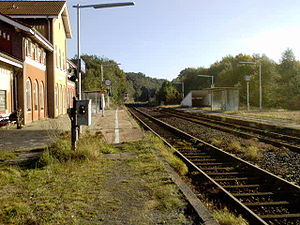Uelzen–Langwedel railway
| Uelzen–Langwedel | ||||||||||||||||||||||||||||||||||||||||||||||||||||||||||||||||||||||||||||||||||||||||||||||||||||||||||||||||||||||||||||||||||||||||||||||||||||||||||||||||||||||||||||||||
|---|---|---|---|---|---|---|---|---|---|---|---|---|---|---|---|---|---|---|---|---|---|---|---|---|---|---|---|---|---|---|---|---|---|---|---|---|---|---|---|---|---|---|---|---|---|---|---|---|---|---|---|---|---|---|---|---|---|---|---|---|---|---|---|---|---|---|---|---|---|---|---|---|---|---|---|---|---|---|---|---|---|---|---|---|---|---|---|---|---|---|---|---|---|---|---|---|---|---|---|---|---|---|---|---|---|---|---|---|---|---|---|---|---|---|---|---|---|---|---|---|---|---|---|---|---|---|---|---|---|---|---|---|---|---|---|---|---|---|---|---|---|---|---|---|---|---|---|---|---|---|---|---|---|---|---|---|---|---|---|---|---|---|---|---|---|---|---|---|---|---|---|---|---|---|---|---|
| Route number: | 116 (Uelzen–Bremen) | |||||||||||||||||||||||||||||||||||||||||||||||||||||||||||||||||||||||||||||||||||||||||||||||||||||||||||||||||||||||||||||||||||||||||||||||||||||||||||||||||||||||||||||||
| Line number: | 1960 | |||||||||||||||||||||||||||||||||||||||||||||||||||||||||||||||||||||||||||||||||||||||||||||||||||||||||||||||||||||||||||||||||||||||||||||||||||||||||||||||||||||||||||||||
| Line length: | 97.4 km | |||||||||||||||||||||||||||||||||||||||||||||||||||||||||||||||||||||||||||||||||||||||||||||||||||||||||||||||||||||||||||||||||||||||||||||||||||||||||||||||||||||||||||||||
| Track gauge: | 1,435 mm | |||||||||||||||||||||||||||||||||||||||||||||||||||||||||||||||||||||||||||||||||||||||||||||||||||||||||||||||||||||||||||||||||||||||||||||||||||||||||||||||||||||||||||||||
|
||||||||||||||||||||||||||||||||||||||||||||||||||||||||||||||||||||||||||||||||||||||||||||||||||||||||||||||||||||||||||||||||||||||||||||||||||||||||||||||||||||||||||||||||
The Uelzen–Langwedel railway runs through the Lüneburg Heath in north Germany in an east-west direction.
The Bremen State Railway, as it was first called, was originally built by the Bremen Senate and opened in 1873. It runs from Lower Saxon Langwedel eastwards through the Lüneburg Heath to Uelzen. The line was renowned as part of the so-called America Line. In Langwedel it formed a junction with the line to Wunstorf, that was owned 50/50 by Bremen and Hanover and operated by the Royal Hanoverian State Railways. Profits on the Langwedel–Uelzen section were initially split in a 2:1 ratio between the Magdeburg-Halberstadt Railway Company (MHE) and Bremen, until operations were taken over by Prussia. At the start of the 20th century the line entered the spotlight as the shortest link between Berlin and the naval base at Wilhelmshaven, which is why several barracks and military training areas were established at Munster (Örtze) and the line doubled in 1907.
Between the wars several express trains ran between Berlin and Wilhelmshaven or Norddeich over this line. In the Second World War the stations were repeatedly the targets of air raids. At the end of the 1930s there was a collision between a bus and Adolf Hitler's train at the level crossing near Walle which resulted in several fatalities. Today the level crossing has gone; in its place is an overbridge for the B 215. The so-called Führerzug ("Führer's train") continued on its way after a short stop at Kirchlinteln. In February 1945 a refugee train was destroyed during an air raid near the villages of Scharnhorst and Walle resulting in a high death toll. Towards the end the line was the scene of heavy fighting between retreating Wehrmacht troops and the advancing British Army.
...
Wikipedia


